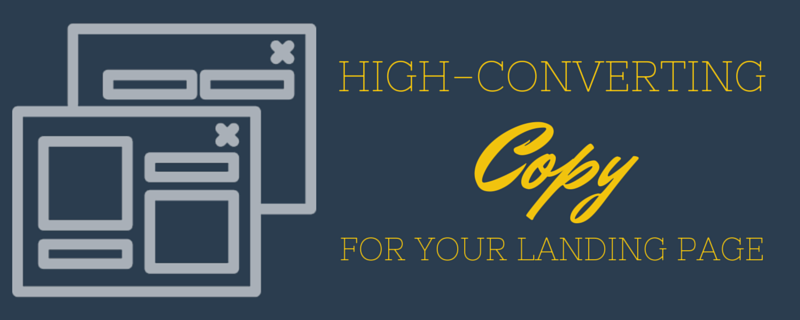BLOG
10 Tips for Copywriting on Landing Pages
Creating great landing pages is a learned art that develops and strengthens overtime. Once you learn and master the tricks of the trade, your landing pages will start generating strong lead conversions.
Looking for ways to create better copywriting on landing pages? Here are our 10 best tips for how to improve great landing pages.
Plan a Journey
Just like planning a holiday, your landing page visitors needs a destination in mind. When your visitors click to your landing page, where is their intended destination or goal? Sign ups for a free promotional trial? Download a free ebook?
Having just one concrete destination in mind will keep you on track as you design the rest of your powerful landing pages. It will also stop you from cluttering your designs or focusing too much on other promotions or features of a product. Plan a journey or goal first before you start designing anything.
Avoid Wordiness
If Ernest Hemingway were alive today, he’d love landing page copywriting. Landing pages should be direct, to the point and devoid of all flowery language. Your sentences should be in the active voice (“We sell shoes, hats and boots” vs. “The shoes, hats and boots are sold by us”) instead of passive voice.
Once you’ve written your copy, go through it again and see if you can make it even tighter. Check for ways to cut out unnecessary adjectives and revise sentences to put them in the active voice.
Add Proof of Social Approval
Having social media sharing buttons can be promoters in their own rights, especially if you have a tracking counter added the the buttons. If more people see that a piece of content is being shared on social media, then they’re more likely to share the content themselves.
Showing number data as social approval can also drive conversions. Listing how many email subscribers you currently have shows that your email newsletters are worth the effort and that plenty of people are currently benefiting from them. If people know that others are downloading or subscribing, they’ll be more apt to do it too.
Pass the Blank Page Test
Write your headline, first paragraph, subheadline or image caption on a blank piece of paper and hand it to your co-worker, boss or even your spouse. Do they understand what you’re trying to sell? Does your headline say something maybe you didn’t intend to say?
Of course, landing pages usually have images and other indicators to viewers to tell them what the product or service is about, but sometimes, we get so wrapped up in our writing that we fail to communicate what it is we’re actually promoting. Do the blank page test with every landing page and get better about being specific and direct.

Make Your Pages Scroll-Proof
Not all visitors will read every word of the copy on the landing page. In fact, few readers read much of it at all. Instead, they skim through the copy and let the bulleted points and bolded headlines and subheadlines stand out to them.
Plan for this by breaking up your landing pages and using a combination of text and bulleted lists.This will accommodate both viewers who read and those who skim all in one punch.
Research Your Audience’s Lingo
Your targeted demographic responds to certain phrases and words. Some compel them to buy and others make them want to hide their wallets forever.
So what are these phrases and words? The only way to find out is to A/B test your landing pages and use different copy to see which is more effective. For example, is “We do not spam” more effective than “Your email address and private information are safe with us”? You won’t know unless you try.
Use the Action-Value Formula for Calls-to-Action
Some marketers settled for the “Click here” or “Buy now” call-to-action (CTA), but does this really work? Maybe in some instances, but overall, your CTAs should direct the viewer to the action that needs to be completed and emphasise the value that completing the action will have on the buyer.
For example, if you’re promoting a free trial offer, you might write, “Discover what our databases have to offer – on us!” or “Sign up and see your ads grow – for free.” The point is to stress how easy it is to complete an action and illustrate how a user will benefit overall from the product.

Experiment with Headlines
Your headlines are the first piece of copy that readers encounter. If there were any other words on your landing pages that need to stand out, it’s the headline copy.
No matter what your headline says, it needs to include the following elements and styles:
- Simple and direct copy
- Focus on one product and one aspect of that product
- Touch on the expectations of a visito
In truth, most copywriters take any “anything-goes approach to headline writing with mixed results. Occasionally, you find something that your prospects respond well to, but in other instances, you need more direction and focus.
Try a few of these headline formulas:
- The Compare and Contrast: “Our Competitor does this poorly, but we, Our Company, do it right.”
- The Promise: “Our promise to you: more job opportunities with our courses.”
- The Benefit: “Get the visibility power of an urban location for your business without sacrificing space.”
Avoid Second-Person Writing
In this article, we’ve done a lot of “you-ing,” meaning we directly addressed the audience. In the realm of landing pages, this often doesn’t work. Readers want to be driven to an action, not feel as if they’re in a choose-your-own-adventure novel (remember, this is an ad, not a fully-fledged article)
Rather than writing “you will save with this product,” direct the reader into the action. Instead write, “Save time and energy with our product,” and place your reader right in the action.
Test Copy Smartly
You have two different landing pages. You want to see which one performs better, so you A/B test them. When one shows more conversions than the other, you decide to stick with it. Then as you start using the same landing page, you notice that conversions remain somewhat static. What is going on?
Testing one landing page against another is only beneficial if you know how to do it correctly. To find out which aspects of your landing pages are successful, you need to test the same landing page with slight variables to determine which ones perform the best. After doing several rounds of testing with the same two landing pages, you’ll get a better idea about what your viewers prefer on their landing pages.
When it comes to landing page secrets, the only true secret is to test, test and test again. For some demographics, the Promise headline won’t be effective, and for others, “We will not spam you” is enough to convince them to fork over their email addresses. Writing good copy for landing pages comes down to testing.
So what are you waiting for? Which tip will you start testing first?











